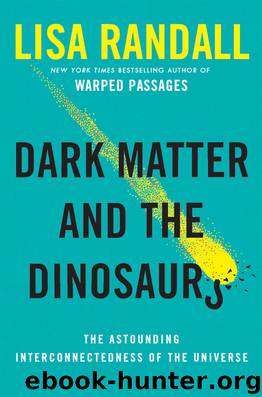Dark Matter and the Dinosaurs by Lisa Randall

Author:Lisa Randall [Randall, Lisa]
Language: eng
Format: epub
Publisher: HarperCollins
Published: 2015-09-14T03:00:00+00:00
STRIKING PAYDIRT: REDISCOVERING THE CRATER
Nonetheless, researchers at the time knew that even with all the evidence discovered in the 1980s and the increased understanding of the implications that a huge meteoroid could have on life on the planet, finding a tangible 66-million-year-old crater of the right size would clearly strengthen the case for the impact suggestion. A crater would not only substantiate the hypothesis, but would permit more detailed investigations that could better pinpoint the size and time of the meteoroid hit, along with other features that could help confirm an impact.
The crater’s size—along with its age—was a critical prediction. Based on the amount of iridium that had been measured, Walter Alvarez deduced that the meteoroid should have been at least 10 kilometers across, so the crater should be about 200 kilometers wide, since craters are usually about 20 times the size of the impacting object. Alvarez wasn’t the only one to estimate a crater of this magnitude. Another paleontologist independently predicted a size of 180 kilometers based on the assumption that the clay contained seven percent meteorite material, with the rest just pulverized rock from the target.
A crater of the right scale from the correct date would be the smoking (technically no longer smoking) gun for the Alvarez proposal. Yet it took more than a decade for the crater to be discovered—spawning one of the best detective stories in modern science. In fact, the odds of finding the impact site didn’t seem all that favorable when people first began to look. Although some large craters have been discovered over the years, many more go missing. Even if we are “lucky” enough that a meteoroid hits land and not the ocean, erosion, burial by sedimentation, or tectonic destruction can eliminate any sign that a crater had been formed.
For the meteoroid responsible for the K-Pg event, the discovery challenge was exacerbated by the apparent lack of clues to the strike’s location. The very ubiquity of the iridium and other geological evidence, distributed more or less uniformly around the globe, confirmed the meteoroid’s worldwide impact but didn’t single out any particular region. When people first began to search, it seemed a daunting, if not impossible, task to determine where on Earth one particular meteoroid had hit more than 65 million years ago.
However, in the crater hunter’s favor, the shocked quartz that had been found suggested its origin was continental—or on a continental shelf—so that searches on land stood a chance of successfully identifying the remains of the culprit. Several seemingly promising candidate craters emerged but were soon ruled out on further investigation—disagreeing with more precise measurements of their time of impact, determinations of their size, or mineralogical studies.
But one very important independent observation had been largely overlooked for quite some time. As early as the 1950s, industrial geologists had identified a buried circular structure 180 kilometers in diameter that extended half onshore, under the Yucatán limestone plains, and half offshore, where it was buried under water and sediment in the Gulf of Mexico.
Download
This site does not store any files on its server. We only index and link to content provided by other sites. Please contact the content providers to delete copyright contents if any and email us, we'll remove relevant links or contents immediately.
| Atomic & Nuclear Physics | Particle Physics |
The Complete Stick Figure Physics Tutorials by Allen Sarah(7307)
Secrets of Antigravity Propulsion: Tesla, UFOs, and Classified Aerospace Technology by Ph.D. Paul A. Laviolette(5309)
Thing Explainer by Randall Munroe(3877)
The River of Consciousness by Oliver Sacks(3538)
The Order of Time by Carlo Rovelli(3145)
How To by Randall Munroe(3033)
A Brief History of Time by Stephen Hawking(2960)
I Live in the Future & Here's How It Works by Nick Bilton(2935)
The Great Unknown by Marcus du Sautoy(2646)
What If?: Serious Scientific Answers to Absurd Hypothetical Questions by Randall Munroe(2637)
Midnight in Chernobyl by Adam Higginbotham(2483)
Blockchain: Ultimate Step By Step Guide To Understanding Blockchain Technology, Bitcoin Creation, and the future of Money (Novice to Expert) by Keizer Söze(2445)
Networks: An Introduction by Newman Mark(2360)
The Meaning of it All by Richard Feynman(2300)
Easy Electronics by Charles Platt(2281)
The Tao of Physics by Fritjof Capra(2229)
Midnight in Chernobyl: The Untold Story of the World's Greatest Nuclear Disaster by Adam Higginbotham(2177)
When by Daniel H Pink(2082)
Introducing Relativity by Bruce Bassett(2076)
